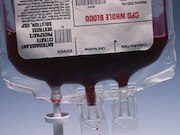Reduction in mortality at 24 hours and 30 days for U.S. military combat casualties in Afghanistan
WEDNESDAY, Oct. 25, 2017 (HealthDay News) — Blood product transfusion pre-hospital or within minutes of injury is associated with improved survival among medically evacuated U.S. military combat casualties in Afghanistan, according to a study published online Oct. 24 in the Journal of the American Medical Association.
Stacy A. Shackelford, M.D., from Fort Sam Houston in San Antonio, Texas, and colleagues examined the correlation of pre-hospital transfusion and time to initial transfusion with injury survival in a retrospective cohort study involving U.S. military combat casualties in Afghanistan. Data were included for 502 patients.
The researchers found that 5 percent of 55 pre-hospital transfusion recipients and 19 percent of 447 nonrecipients died within 24 hours of medical evacuation (MEDEVAC) rescue (between-group difference, −14 percent). By day 30, 11 and 23 percent had died (between-group difference, −12 percent). The adjusted hazard ratio for mortality associated with pre-hospital transfusion was 0.26 and 0.39 over 24 hours and 30 days, respectively. There were correlations for time to initial transfusion, regardless of location, with reduced 24-hour mortality only up to 15 minutes after MEDEVAC rescue (median, 36 minutes after injury: adjusted hazard ratio, 0.17).
“Among medically evacuated U.S. military combat causalities in Afghanistan, blood product transfusion pre-hospital or within minutes of injury was associated with greater 24-hour and 30-day survival than delayed transfusion or no transfusion,” the authors write. “The findings support pre-hospital transfusion in this setting.”
Abstract/Full Text (subscription or payment may be required)
Editorial (subscription or payment may be required)
Copyright © 2017 HealthDay. All rights reserved.








